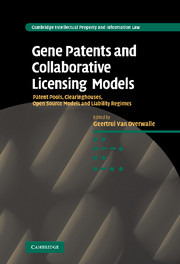 Gene Patents and Collaborative Licensing Models
Gene Patents and Collaborative Licensing Models Book contents
- Frontmatter
- Contents
- List of contributors
- Preface
- Foreword: Jean-Jacques Cassiman
- List of abbreviations
- Part I Patent pools
- Part II Clearinghouses
- Part III Open source models
- 12 Open source genetics. Conceptual framework
- 13 Case 8. CAMBIA's Biological Open Source Initiative (BiOS)
- 14 Case 9. Diversity Arrays Technology Pty Ltd. (DArT) Applying the open source philosophy in agriculture
- 15 Critical commentary on ‘open source’ in the life sciences
- 16 Several kinds of ‘should’. The ethics of open source in life sciences innovation
- Part IV Liability regimes
- Part V Different perspectives
- Part VI Summary and concluding analysis
- Index
- Titles in the series
12 - Open source genetics. Conceptual framework
from Part III - Open source models
Published online by Cambridge University Press: 14 January 2010
- Frontmatter
- Contents
- List of contributors
- Preface
- Foreword: Jean-Jacques Cassiman
- List of abbreviations
- Part I Patent pools
- Part II Clearinghouses
- Part III Open source models
- 12 Open source genetics. Conceptual framework
- 13 Case 8. CAMBIA's Biological Open Source Initiative (BiOS)
- 14 Case 9. Diversity Arrays Technology Pty Ltd. (DArT) Applying the open source philosophy in agriculture
- 15 Critical commentary on ‘open source’ in the life sciences
- 16 Several kinds of ‘should’. The ethics of open source in life sciences innovation
- Part IV Liability regimes
- Part V Different perspectives
- Part VI Summary and concluding analysis
- Index
- Titles in the series
Summary
Introduction
Intellectual property (IP) rights are most often thought of as regulatory tools employed by the state to facilitate bargaining and induce investment in the risky but socially valuable process of innovation. However, they can also be regarded as private regulatory tools that enable their owners to order markets by fixing prices and controlling the availability of protected goods and services. The strategic use of patents and other IP rights to discipline international markets was foreshadowed by free market economists more than a century ago, and has since been dubbed the ‘knowledge game’.
It is well established that IP rights can serve the public interest only if they strike an appropriate balance between upstream and downstream innovation. In the context of gene patenting, for example, the ‘tragedy of the anticommons’ is a familiar concept. But the knowledge game is not predicated on a careful balance between the interests of initial and follow-on innovators. Rather, it depends on uniformly high standards of IP protection. The political history of international IP standard setting at the GATT Uruguay Round and beyond shows that the concentrated interests of elite knowledge game players are more than a match for the diffuse interests of those who engage in and benefit from downstream innovation. The outcome is a global IP ratchet in which minimum standards of protection are gradually pushed higher and higher, with little scope for downward adjustment.
- Type
- Chapter
- Information
- Gene Patents and Collaborative Licensing ModelsPatent Pools, Clearinghouses, Open Source Models and Liability Regimes, pp. 171 - 193Publisher: Cambridge University PressPrint publication year: 2009
- 4
- Cited by


